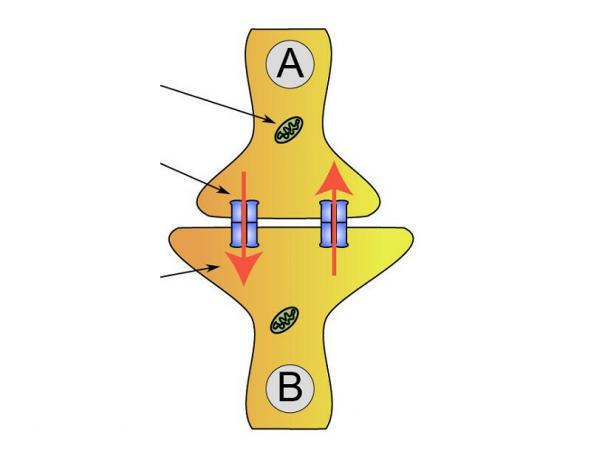Synapse: what they are, types and functions
The nervous system is one of the most important elements for our existence and survival, since it allows the management, organization and operation of the rest of the body systems. This system works by sending electrochemical impulses with different information and orders for the different structures that are part of our body.
Formerly it was believed that the nervous system was a continuous network without separation between elements, until Ramón y Cajal, through of tinctures such as Golgi, allowed to identify that it is actually made up of a set of cells separated from each other: the neurons. These are separated by small spaces, but they do not stop communicating with each other. The connection between them is what is known as synapses..
Throughout this article you will find a summary about what neuronal synapses are and what their different types are according to various classification modes.
- Related article: "Ramón y Cajal explained how the brain works with these drawings"
What is a synapse?
The concept of synapse, first described by Ramón y Cajal and baptized by Sherrington, refers to the existence of a connection between two neurons, characterized by the presence of a small space that serves as a channel for the transmission of information. That is to say: the existence of synapses shows us that neurons do not form a compact cellular tissue, but rather that are interconnected with each other in complex ways and maintaining a certain independence from each other.
The main function of this connection is to allow the transmission of information between the different neurons. It is therefore a fundamental element in the functioning of the organism, making it possible to carry out and coordinate all processes that allow the different vital functions to be carried out, as well as physical and mental capacities, both basic and superiors.
This connection is also very useful not only to transmit information, but also to regulate it: the presence of the synaptic space makes that the presynaptic neuron can reuptake neurotransmitters if an excessive amount has been released. Likewise, it is very useful in the sense that it allows the waste generated by the operation neuronal cells are eliminated by each cell, preventing their wear due to the concentration of said residues.
In addition, it must be taken into account that throughout the life cycle of a neuron the number and the way in which it establishes these connections with other nerve cells change; our ability to learn and adapt to the situations to which we expose ourselves on a day-to-day basis depends on it.

- You may be interested: "Types of neurotransmitters: functions and classification"
Main components
The synapse between two neurons, the connection and bonding between them that allows information to be transmitted, is not an isolated element, but is composed of three main components among which we find part of both neurons in interrelation: presynaptic neuron, synaptic space and neuron postsynaptic.
1. Presynaptic neuron
This part refers to the neuron that sends the information to another. This action is usually carried out through the emission of neurotransmitters by synaptic vesicles terminal buttons at the end of the axon, which in turn will be received by the membrane of the postsynaptic neuron.
2. Synaptic space
The synaptic space or synaptic cleft is the space between two neurons, generally between twenty to forty nanometers. It is the space in which the transmission of information between neurons takes place.
3. Postsynaptic neuron
It is the receptor part in the relationship between neurons. More than the neuron itself, we would refer to the part of it that receives the information from the presynaptic neuron. These are generally the dendrites, although depending on the type of connection they can also be the soma or the axon.
- Related article: "What are the dendrites of neurons?"
Synapse types
There is no single type of synapse, but different classifications and typologies can be found depending on different parameters, such as the place where they generate the connection with another neuron or the type of elements that circulate between they.
This is to be expected, taking into account that the nervous system has evolved to adjust in the best possible way to the survival challenges to which it is necessary to adapt; considering that having only one way to create connections between neurons would not be efficient (because different parts of the body are associated with different functions), there are several ways to establish these links between cells nervous Thus, we can find among others the following types of synapses.
Types according to what is transmitted
According to the type of element that is transmitted between neurons, we can find the following. Despite its distinction, it must be taken into account that it is common for the same neuron to have a chemical and electrical connection at the same time, as well as the fact that the information that runs through the system is generally bioelectric (that is, Although chemical elements are transmitted between neurons, what they generate are alterations of the electric).
Chemical synapses
Its about type of synapse in the majority in our body. In these synapses the information is transmitted chemically, through the sending by the presynaptic neuron of different neurotransmitters that the postsynaptic neuron captures through different receptors, whose action generates an alteration in the form of potential excitatory or inhibitory postsynaptic that may or may not end with the generation of an action potential by the neuron postsynaptic. They are versatile synapses, since some neurons can inhibit the action of others depending on what is activated. There is no physical contact between both neurons.

Electrical synapses
In this type of synapse, information is transmitted directly at the electrical level as the ions flow directly between the pre and postsynaptic component. They do not have versatility, since its action does not allow one neuron to inhibit the action of another. In this type of synapse, there is actually a contact between the pre- and postsynaptic neuron, through the gap junctions or channels formed by proteins.
They are typical of the optic nerve and its connection with rods and cones in the eye. Also of invertebrate animals.

Types according to the effect
The interaction between neurons can have mainly two effects, corresponding to the following types of synapses.
Excitatory synapse
Type of synapse in which the transmission of information has excitatory effects, facilitating the postsynaptic neuron to perform an action potential and the transmission of the message is continued by generating the depolarization of its membrane.
Inhibitory synapse
In this case, the performance or activation of this type of synapse hinders the appearance of an action potential by hyperpolarizing the postsynaptic cell. It becomes more difficult for information to be transmitted through the postsynaptic neuron to others connected to it.
According to connection place
Depending on where they connect to each other, we can find the following types of synapses.
Axodendritic synapses
The most frequent and prototypical type of connection. The synaptic connection occurs between the axon of the presynaptic neuron and the dendrites of the postsynaptic neuron. It generally has excitatory effects.
Axosomatic synapses
In this type of synapse, the axon of the presynaptic neuron connects with the soma or nucleus of the postsynaptic. It generally has inhibitory effects on the second.
Axo-axonal synapses
This type of connection usually occurs in such a way that modulating effects are exerted when one neuron releases certain amounts of neurotransmitter towards another. There is a connection between the axon of the presynaptic and postsynaptic neuron, altering the possibility that it releases certain amounts of neurotransmitters to a third with which it is connected by another via.
